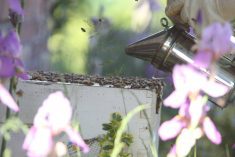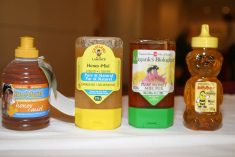WINNIPEG — Canadian beekeepers have a problem in Japan.
A percentage of Canadian honey contains trace amounts of quinclorac, a herbicide used to control cleavers in canola.
Related story: Honey obtains halal certification
Japanese buyers have adopted a stringent residue limit for quinclorac in honey of 0.01 parts per million. As a result, less product is being shipped to Japan, said Rod Scarlett, Canadian Honey Council executive director.
He said beekeepers will often hold back in shipping to Japan if their honey is close to the residue limit.
Read Also

Russian wheat exports start to pick up the pace
Russia has had a slow start for its 2025-26 wheat export program, but the pace is starting to pick up and that is a bearish factor for prices.
Canadian beekeepers have been dealing with this issue for almost two years, so they get honey tested before exporting to Japan. They don’t want the risk and cost of shipping across the Pacific, only to have the honey rejected in Japan.
Some beekeepers continue to export to Japan because their honey is free from quinclorac, but overall exports have decreased.
Fewer sales are a loss for Canada’s honey industry because Japanese buyers pay premium prices. In 2021 it was the largest export market for Canada, and beekeepers shipped $25 million worth of honey to Japan.
Simon Lalonde, a beekeeper from Clavet, Sask., likes to sell part of his crop to Japanese buyers. In previous years, he has shipped anywhere from 20 to 300 tonnes to Japan, a country that imports $150-$200 million worth of honey annually.
That market is now partially closed due to quinclorac residues.
“Our frustration … is it’s not a customs or government requirement to get into (Japan). It’s just something that’s been imposed by the packers (in Japan),” Lalonde said last year.
Japanese honey buyers don’t have evidence or data showing that quinclorac above 0.01 p.p.m. is a risk to human health but they’ve imposed that limit anyway.
To put 0.01 parts per million in context, it is 10 parts per billion. One part per billion is equivalent to one second in 32 years.
The honey council has reached out to groups that represent canola growers in attempts to understand the cause.
In some regions of the Prairies, quinclorac in honey is non-existent. In other areas it is commonplace.
“The majority of the honey being tested … is close to that 0.01 p.p.m.,” Scarlett said. “The work we’ve had done still kind of indicates that (variability). It’s very much regional. We can’t really say there’s a province that’s clear … It kind of goes in fits and starts.”
Residues in western Canadian honey could be connected to a decision from 2018, when an international body, the Codex Alimentarius Commission, adopted a maximum residue level (MRL) for quinclorac in canola.
Prior to that decision, China didn’t have an MRL for quinclorac in canola, so canola growers had to sign a declaration at their local elevator saying they hadn’t applied the herbicide to their fields.
With the Codex approval, China followed suit and adopted the recommended MRL. That allowed Canadian farmers to use the herbicide.
“Coming in 2019, Canadian growers can use Facet L herbicide in their canola to get the best available cleaver control in Canada, while having confidence in the marketability of their crop,” said Sydney Marlow, canola crop manager for BASF Canada, in August 2018.
That change meant more canola growers could use Facet L to control cleavers. But quinclorac is now applied to a small percentage of canola acres, a BASF spokesperson said in 2023.
“BASF Canada is one of a few registrants that sell quinclorac products in Canada,” they said.
“The product is a very niche product for cleaver control and is applied to a single-digit per cent of the total canola treated in Western Canada.”
That leads back to the question: if quinclorac is only applied to a fraction of the canola crop, why does it appear in a significant portion of honey samples?
Scarlett doesn’t have an answer. For now, it remains a mystery.
“We’re trying to figure this out.”
For its part, BASF Canada is studying the issue and is working with other ag industry groups, a spokesperson said in an email.
“BASF is currently reviewing this topic and as we do that, we’ll be engaging with members of the industry to help facilitate and inform our review.”
Contact robert.arnason@producer.com
















